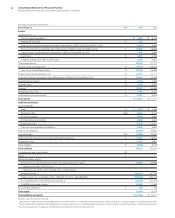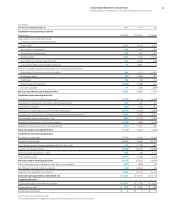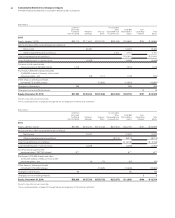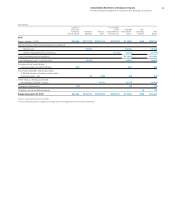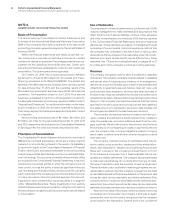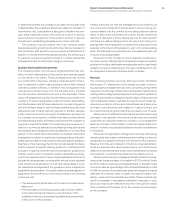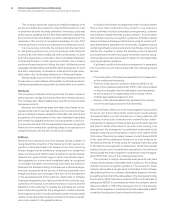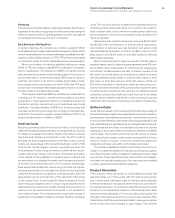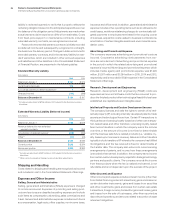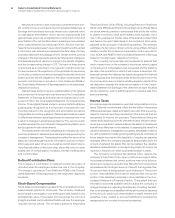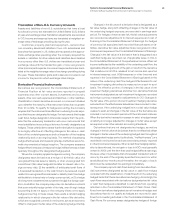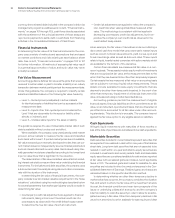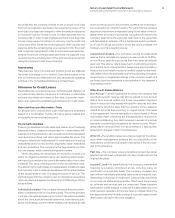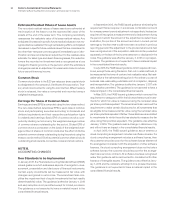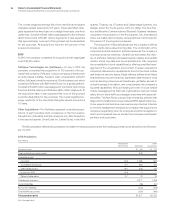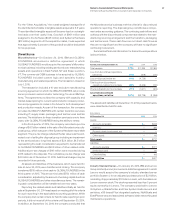IBM 2015 Annual Report Download - page 90
Download and view the complete annual report
Please find page 90 of the 2015 IBM annual report below. You can navigate through the pages in the report by either clicking on the pages listed below, or by using the keyword search tool below to find specific information within the annual report.Notes to Consolidated Financial Statements
International Business Machines Corporation and Subsidiary Companies
88
Net periodic pension and nonpension postretirement ben-
efit cost/(income) is recorded in the Consolidated Statement of
Earnings and includes service cost, interest cost, expected return
on plan assets, amortization of prior service costs/(credits) and
(gains)/losses previously recognized as a component of OCI and
amortization of the net transition asset remaining in accumulated
other comprehensive income/(loss) (AOCI). Service cost rep-
resents the actuarial present value of participant benefits earned
in the current year. Interest cost represents the time value of money
cost associated with the passage of time. Certain events, such as
changes in the employee base, plan amendments and changes in
actuarial assumptions, result in a change in the benefit obligation
and the corresponding change in OCI. The result of these events
is amortized as a component of net periodic cost/(income) over
the service lives or life expectancy of the participants, depending
on the plan, provided such amounts exceed thresholds which are
based upon the benefit obligation or the value of plan assets. Net
periodic cost/(income) is recorded in Cost, SG&A and RD&E in
the Consolidated Statement of Earnings based on the employees’
respective functions.
(Gains)/losses and prior service costs/(credits) not recognized
as a component of net periodic cost/(income) in the Consolidated
Statement of Earnings as they arise are recognized as a com-
ponent of OCI in the Consolidated Statement of Comprehensive
Income. Those (gains)/losses and prior service costs/(credits) are
subsequently recognized as a component of net periodic cost/
(income) pursuant to the recognition and amortization provisions
of applicable accounting guidance. (Gains)/losses arise as a result
of differences between actual experience and assumptions or as
a result of changes in actuarial assumptions. Prior service costs/
(credits) represent the cost of benefit changes attributable to prior
service granted in plan amendments.
The measurement of benefit obligations and net periodic cost/
(income) is based on estimates and assumptions approved by the
company’s management. These valuations reflect the terms of the
plans and use participant-specific information such as compen-
sation, age and years of service, as well as certain assumptions,
including estimates of discount rates, expected return on plan
assets, rate of compensation increases, interest crediting rates
and mortality rates.
Defined Contribution Plans
The company’s contribution for defined contribution plans is
recorded when the employee renders service to the company.
The charge is recorded in Cost, SG&A and RD&E in the Consoli-
dated Statement of Earnings based on the employees’ respective
functions.
Stock-Based Compensation
Stock-based compensation represents the cost related to stock-
based awards granted to employees. The company measures
stock-based compensation cost at the grant date, based on the
estimated fair value of the award and recognizes the cost on a
straight-line basis (net of estimated forfeitures) over the employee
requisite service period. The company grants its employees
Restricted Stock Units (RSUs), including Retention Restricted
Stock Units (RRSUs) and Performance Share Units (PSUs). RSUs
are stock awards granted to employees that entitle the holder
to shares of common stock as the award vests, typically over a
one- to five-year period. The fair value of the awards is determined
and fixed on the grant date based on the company’s stock price,
adjusted for the exclusion of dividend equivalents. The company
estimates the fair value of stock options using a Black-Scholes
valuation model. Stock-based compensation cost is recorded in
Cost, SG&A, and RD&E in the Consolidated Statement of Earnings
based on the employees’ respective functions.
The company records deferred tax assets for awards that
result in deductions on the company’s income tax returns, based
on the amount of compensation cost recognized and the statutory
tax rate in the jurisdiction in which it will receive a deduction. Dif-
ferences between the deferred tax assets recognized for financial
reporting purposes and the actual tax deduction reported on the
income tax return are recorded in additional paid-in capital (if the
tax deduction exceeds the deferred tax asset) or in the Consol-
idated Statement of Earnings (if the deferred tax asset exceeds
the tax deduction and no additional paid-in capital exists from
previous awards).
Income Taxes
Income tax expense is based on reported income before income
taxes. Deferred income taxes reflect the tax effect of temporary
differences between asset and liability amounts that are recog-
nized for financial reporting purposes and the amounts that are
recognized for income tax purposes. These deferred taxes are
measured by applying currently enacted tax laws. Valuation allow-
ances are recognized to reduce deferred tax assets to the amount
that will more likely than not be realized. In assessing the need for a
valuation allowance, management considers all available evidence
for each jurisdiction including past operating results, estimates of
future taxable income and the feasibility of ongoing tax planning
strategies. When the company changes its determination as to the
amount of deferred tax assets that can be realized, the valuation
allowance is adjusted with a corresponding impact to income tax
expense in the period in which such determination is made.
The company recognizes tax liabilities when, despite the
company’s belief that its tax return positions are supportable,
the company believes that certain positions may not be fully sus-
tained upon review by tax authorities. Benefits from tax positions
are measured at the largest amount of benefit that is greater than
50percent likely of being realized upon settlement. The current
portion of tax liabilities is included in taxes and the noncurrent
portion of tax liabilities is included in other liabilities in the Con-
solidated Statement of Financial Position. To the extent that new
information becomes available which causes the company to
change its judgment regarding the adequacy of existing tax liabil-
ities, such changes to tax liabilities will impact income tax expense
in the period in which such determination is made. Interest and
penalties, if any, related to accrued liabilities for potential tax
assessments are included in income tax expense.


